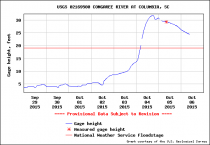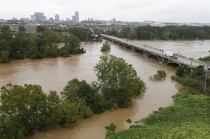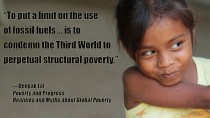
Weekly rainfall from a strong non-tropical low in the southeast. Some areas had over 25 inches of rain.
There is no question that the flooding in South Carolina is exceptional, even historic.
But a once on 1,000 year event? Sorry, but there is no way to determine that...there are simply not enough rainfall statistics over a long enough period of time to establish such a claim.
But we do have information on previous floods over the last 100 years or so. So, let’s look at how the current event compares.
The greatest multi-day rainfall reported on the CoCoRaHS cooperative rainfall monitoring website was 27 inches in Columbia, SC. The Congaree River crested at 31 ft. there on Sunday:

Enlarged
Congaree River gage height at Columbia, SC.
Here’s a photo taken about the time the river crested:

Enlarged
Photo of Congaree River, Columbia, SC, Oct. 4, 2015, taken about the time of cresting.
Now, for comparison, take a look at a bridge over the Congaree River during the record flood of 1908, when the river crested at 40 ft...about 9 ft. higher than the current flood event:

Congaree River bridge in Columbia, SC, during the 1908 record flood event. Enlarged
Not to discount the misery and likely billions of dollars of damage caused by the current event, but when someone claims that a weather disaster is 1 in a 1,000 year event, they need to back it up.
Unfortunately, there seems to be an trend toward classifying events as “1 in 1,000 years”, when there is no way of knowing such things. This is especially true for floods, where paving of urban and suburban areas causes increasing runoff, making river flooding worse for the same amount of rainfall. This is a big reason why flood events have gotten worse in the last 100 years...it has nothing to do with “climate change”.
For some areas the current flood is no doubt a 1 in 100 year event, or even worse. But remember, it is perfectly normal to have a 1 in 100 year event every year...as long as they occur in different locations.
There are two stories floating around about the state of the earth’s atmosphere. Both are believed true by government-funded scientists and the environmentally minded. The situation is curious because the stories don’t mesh. Yet, as I said, both are believed. Worse, neither is true.
Story number one is that this year will be the hottest ever. And number two is that the reason it is not hot is because “natural variation” has masked or stalled man-caused global warming.
Which is it? Either it’s hotter than ever or it isn’t. If it is, then (it is implied) man-caused global warming has not “paused.” If it isn’t, if man-caused global warming has “paused,” then it is not growing hotter.
There are two things to keep straight: (1) why these divergent contentions are believed, and (2) why they are incompatible and individually false. The first point is easy. Climatology has become a branch of politics. And in politics, particularly in our rambunctious democracy, statements asserted in the name of some political goal are usually believed or at least supported by those who share the goal. It is necessary for global-warming-of-doom to be true in order to attain the government’s goal (of increasing in size and power), so any statement which supports global warming is likely to be touted by government supporters, even mutually incompatible statements.
Scientists - and some very big names indeed - who have made their living on government grants, and who provide arguments in line with the government’s desire that global-warming-of-doom be true, recently wrote a letter to the President and Attorney General asking these officials to criminally prosecute under the RICO Act scientists like myself and organizations that might fund me. Which scientists and organizations? Those, they say, who have “knowingly deceived the American people about the risks of climate change, as a means to forestall America’s response to climate change.”
In other words, arguments put forth by independent scientists and organizations that do not support the government’s line cannot be considered science, but should instead be classified as criminal acts. Incidentally, it has come out that the scientist leading the effort to prosecute the innocent has “paid himself & his wife $1.5 million from gov’t climate grants for part-time work.” Climatology is thus a branch of politics. Quod erat demonstrandum.
I’m no politician and can’t predict what will come of this. But I am a scientist and know good physics from bad. To understand why the claims about the atmosphere mentioned above are false, it is necessary to grasp, at least in broad outline, some rather complicated statistics and physics. Let’s try.
Claim Number One: This Year Will Be The Hottest Ever
The first claim is not only false, it is ludicrously false. It’s not even close to being true. There have been times in the history of the earth when it was much hotter. Here is a link to one estimate of the earth’s mean temperature over time.
But haven’t atmospheric carbon dioxide levels risen over the past few decades? Yes, but here is another link with carbon dioxide levels plotted alongside temperature (see the second graph down at the link) showing how the two do not track each other and at times have even moved in opposite directions.
Jurassic Period Hot Steamy JungleWe are now geologically in what is called the Quaternary Period, which is characterized by periodic cold snaps, which is to say, glaciations. Glaciers have come and glaciers have gone for more than two million years, and we expect they’ll continue to come and go mainly because of the way the earth wobbles and wends it way around the sun. Before the Quaternary was the Pliocene, and well before this was the better known (thanks, Hollywood!) Jurassic, which ran 145 to 200 million years ago. And before the Jurassic was the Triassic, extending back another 25 millions years.
From the Triassic to the Quaternary, a time spanning more than 200 million years, the earth was hotter than it is now, and not just a little hotter, but downright steamy at times, with temperatures 10 or more degrees Celsius higher. It was so hot that the entire planet was green and fertile, and animals, you might recall, grew to tremendous size. Before the Triassic there were other periods, some of which more closely resembled ours in climate.
The lesson to be learned from this is that the climate is never constant; it always has changed and always will. Stopping climate change is a human impossibility. I mean this word in its strict sense. There is no power short of Omnipotence that can stop the climate from changing. Certainly no government can. To plead, therefore, that we should stop climate change is not to engage in science, but politics.
Above I said the linked picture represented an estimate of the temperature, and this is so. Thermometers didn’t exist in any reliable or widespread sense until the last 100 or so years of earth’s history, and even now these only cover a small fraction of the earth’s surface. And even in the modern era, the ways we have of measuring temperature have varied and still vary. Satellites, which provide some of the best, but still imperfect, global measurements have only existed about 50 years.
That means if we want to know the temperature before 50-100 years ago, we have to guess. It’s not a blind guess, though, since we can use so-called “proxies.” These are chemical and physical measurements known to be correlated with air temperature. We can tally these over geologic times and plug them into a statistical model that predicts what the temperatures were. There is nothing wrong with this except for two things. Here it gets a bit technical.
No statistical guess should be stripped of its uncertainty. We don’t want the temperature guess alone, we want it with a plus-or-minus the guess attached. The first problem is that these plus-and-minuses are almost always absent. The result is over-certainty in statements about what the past was compared with the present. Sometimes uncertainty in the temperature guesses is provided, but it’s the wrong kind of uncertainty, the wrong plus-or-minuses.
All these statistical models have innards called parameters, which are nothing more than mathematical “dials” necessary for the equations to work out. Unfortunately, a fallacy has become ingrained in science that these parameters directly represent or are reality. This fallacy is so ubiquitous that I call it the Cult of the Parameter. The fallacy is harmful because the plus-and-minus bounds to reality are necessarily larger than the plus-or-minus bounds to model parameters (usually 4 to 8 times larger). The result is always dramatic over-certainty.
And it’s still worse. The models take proxy measurements, but the uncertainty in the time those proxies were laid down in history is always discarded in the statistical models. How do you know the proxy you measured was 1.10 and not 1.11 million years ago? Answer: you don’t.
The end result is to make temperature guesses appear smooth and uncomplicated, which is an illusion. That illusion makes it easier for (actually measured) temperatures in modern times to appear more variable. And that makes it easier to appear that we are hotter now, even if we’re not. Add to that the observations that modern records are continually being tweaked by scientists (and strangely always in a direction that makes it appears colder then and warmer now), and it’s no surprise to hear talk of “record temperatures.”
Now if we only go by the satellite record, it’s quite easy to be in a “record-breaking” year, for the trivial reason that there only a few years on the books. Every year stands a good chance at breaking some kind of atmospheric record. But because of the entire geologic record, the chance of breaking real records is not even remote; it’s nearly impossible.
Scientists know all these facts, yet some still make the statement that this year will be (or could be) the hottest. They say it while knowing it isn’t true. Why?
(Those who want more technical detail can go here to learn about the BEST project’s statistical reconstruction of historical temperatures, which is touted to be the “best” but which commits the errors noted here.)
Claim Number Two: Natural Variation Caused A “Pause”
The American Meteorological Society is, or rather was, the preeminent organization for those who study weather and climate. Its official organ is known as BAMS, the Bulletin of the American Meteorological Society. BAMS is used to impart news items of interest and the like, but it also publishes review articles on the state of science.
Now the AMS has, like nearly all other government-money-dependent scientific organizations, given up all pretense of physics and has instead embraced politics as its raison d’etre. So far removed from its original mission is the AMS that they are publishing a BAMS review article by two non-scientist ideologues and one scientist who writes mostly about politics. The title is “The ‘Pause’ in Global Warming: Turning a Routine Fluctuation into a Problem for Science.”
The authors are Stephan Lewandowsky, a psychologist who specializes in gimmicked surveys, Naomi Oreskes, a historian who believes in a vast right-wing conspiracy, and James Risbey, a real climatologist who spends much of his time wondering why everybody doesn’t agree with him (he has more than one paper with Lewandowsky and Oreskes on this theme).
The point of this new paper is the same as all of Lewandowsky’s works. He wants to paint detractors of The Consensus as crazy or oil-industry stooges. For these authors, and for many, the mere fact that government-funded scientists have said a problem with the atmosphere exists and that only government can solve it is more than sufficient proof of the contention. Any who disagree must be doing so out of ignorance, insanity or evil intent. That their position on the science might be wrong never occurs to them.
And they are wrong. Their claim is that the (satellite) observed non-increase in global temperatures over the past two decades was caused by any or some combination of these: “natural variations,” El Nino, the Pacific Decadal Oscillation, “random” or “routine fluctuations” and the like. They say that if these “causes” did not exist, the temperatures would have increased just as they were predicted to under the theory of enhanced-feedback carbon-oxide-driven (EFCOD) global warming.
Do you see the fallacy? They use the absence of predicted increases as proof the increases were really there, but in masked or modified form! To them, the repeated, consistent and egregiously mistaken predictions made by climate models are true no matter what because EFCOD global warming is true no matter what. It used to be in science that when a theory made predictions even as fractionally lousy as EFCOD global warming, it was quietly removed from service. But global warming can’t be dropped. There is too much riding on it remaining in force.
And this is not the only or even the worst fallacy. Having faith in lovingly created but failed theories is an error, but it is an understandable human foible. No one wants to disown his child, no matter how ugly. Our response to a scientist who doesn’t want to give up his life’s work should be pity, not condemnation.
But making statements physically impossible is not forgivable, not for those who call themselves physicists. The real blunder is this. Scientists claimed to understand how the atmosphere worked. Based on this understanding, they said that “disruptive,” “dangerous” global warming would soon be upon us. It didn’t happen. What went wrong? El Nino, they say.
But El Nino, “natural fluctuations” and the like are not things separate from the atmosphere. They are part of the atmosphere. These things are nothing more than human-labels given to particular measures of the atmosphere. El Nino is not a primary cause, it is an effect, an observation. “Natural fluctuations” means “what the atmosphere does.” Thus it is a tautology, an observation empty of scientific content, to say “what the atmosphere does” caused “what the atmosphere did.”
These “routine fluctuations” and the like are part of what the scientists said they already understood. They are not alien entities that arrive unexpectedly and upset theory; they are, or should have been, an integral part of EFCOD global-warming theory. These things are the atmosphere, they are the climate.
It is thus clear that scientists who blame these phenomena for their failings don’t know what they are talking about. They said they understood the atmosphere, and here is proof they did not. So why should we continue to believe them when they say, “The time to act is now”?
We now see that the word “pause” is a terrible misnomer, a circularity. It states what it seeks to prove. To say there is a “pause” is to claim that we know why the atmosphere is doing what it is doing. But if that were so, then the models over the past two decades would have made successful predictions. They made atrocious predictions, and they are growing worse. That means to say there is a “pause” is equivalent to we know global warming is there because we can’t see it.
It is well past the time to move on from EFCOD global warming and return to doing real science.
Pope Francis and President Obama: Fight Poverty by Not Fighting Global Warming
By E. Calvin Beisner, Roy W. Spencer, Charles A. Clough, and Timothy D. Terrell,
On September 23, 24, and 25, Pope Francis will meet with President Barack Obama at the White House, speak to a joint session of Congress, and address the General Assembly of the United Nations in New York. A major thrust of his message will be to urge action to reduce manmade global warming something to which President Obama is already committed.
We offer a dissenting opinion.
This is a huge and incredibly complex topic that we can only begin to unpack here. We and other scholars have discussed it at length in five major papers by the Cornwall Alliance for the Stewardship of Creation, the latest of which is A Call to Truth, Prudence, and Protection of the Poor 2014: The Case against Harmful Climate Policies Gets Stronger (all at http://www.cornwallalliance.org/landmark-documents/), which provide more details, plus documentation for many of the facts we state here.
Pope Francis, President Obama, and many others believe anthropogenic (manmade) global warming is so dangerous that the peoples of the world should spend literally trillions of dollars trying to prevent it by reducing emissions of carbon dioxide (CO2), which would require tremendous reductions in the use of fossil fuels (coal, oil, and natural gas) for electricity and vehicle fuels.
There are two problems with this. The first is that the claim of dangerous manmade warming is almost certainly false, which we’ll discuss in a moment. The second, which we’ll mention only briefly, is that spending all that money on mitigating climate change means not spending it on much more urgent problems like access to pure drinking water, sewage sanitation, adequate nutrition, communicable diseases, air and water and solid waste pollution, and access to electricity, all of which are of greatest concern to the world’s poor today.
Now to the first point. Claims of dangerous manmade warming require that CO2 added to the atmosphere has a very strong warming effect, not just because of its own direct warming but far more because of positive feedbacks - responses in the climate system that multiply the direct warming. That hypothesis is assumed in the computer climate models on which the U.N. Intergovernmental Panel on Climate Change (IPCC) and various government agencies and national academies of science based their conclusions.
But it’s crucial to remember that models and the scenarios they generate are not evidence but hypotheses. The models are useful to predict the future, and hence to inform policy, only if they are validated. But as Nobel Prize-winning physicist Richard Feynman famously said, “the key to science” is that when you’ve formulated a hypothesis about how the world works, you must test it rigorously against empirical observations, whether in laboratory experiments or, better yet, in the outside world. “If it disagrees with experiment [that is, observation] it is wrong...It does not make any difference how beautiful your guess is. It does not make any difference how smart you are, who made the guess, or what his name is - if it disagrees with experiment it is wrong. That is all there is to it.”
The conscientious scientist disciplines herself to look for evidence against her hypothesis even harder than she does for evidence supporting it, because she knows how easy it is to ignore contrary evidence because she wants to be proven right. Unfortunately, the IPCC, the government agencies, and the national academies have mostly done the opposite: they’ve looked only for confirming evidence, not for contrary.
So, how do the models do against observation? On average, they simulate twice as much warming as actually observed over the relevant period. Over 95 percent simulate more warming than actually occurred, which means the errors are not random (in which case they’d have been evenly distributed above and below observations) but driven by some kind of bias. And none of them simulated the complete absence of statistically significant global warming for about the last 17 to 27 years, depending on which database you consult - 18 years and 8 months, according to the satellite record, which is the most reliable.
This is probably sufficient to conclude that the models are invalidated - or, to use Feynman’s term, “wrong.” At the very least, it means the models are unvalidated. And again, models are useful for predicting the future, and so for policymaking, only if they’re validated. So the models provide no rational grounds for implementing any predictions about future temperature, and therefore no rational basis for any policy.
We can go further.
On the one hand, we can be more specific about CO2’s actual warming effect. The most empirically driven studies of CO2’s warming effect, direct and indirect combined, now point toward something on the order of 0.5–1.0 C for every doubling of CO2 (which takes hundreds of years so far we’ve added only about 40 percent since the Industrial Revolution) instead of the roughly 3.0 C generated by the models.
Most of that warming would be poleward, in winter, and at night, not in warmer regions, in summer, or in the daytime. That’s not dangerous, and in fact in most parts of the world it would be beneficial, lengthening growing seasons, expanding farmable regions into higher latitudes and altitudes, and reducing risks from winter cold. (This certainly was the effect in the Medieval Warm Period, when lengthened growing seasons made food more plentiful, enabling population to triple, and warmer temperatures allowed settlement of Iceland and Greenland.) Therefore there is little or nothing to fear about the slight warming our CO2 emissions might cause, and little or no justification for any policy to reduce CO2 emissions - especially one costing trillions of dollars that could be better spent solving more urgent problems.
On the other hand, there is abundant empirical evidence that adding CO2 to the atmosphere is good for all of life. CO2 is plant food. Every doubling of the concentration of CO2 in the atmosphere brings an average 35 percent increase in plant growth efficiency. Plants do better in warmer and colder temperatures and in wetter and drier soils when there is a greater concentration of CO2. They make better use of soil nutrients. They resist disease and pests better. They improve their fruit-to-fiber ratio. In short, more CO2 means more plants and therefore more food for everything that eats plants or eats something that eats plants - which is essentially all life. And the best news about this is for the poor, because they are most affected by food prices. More food means less expensive food.
Continue reading at Pope Francis and President Obama: Fight Poverty by Not Fighting Global Warming
--------------
Open Letter on Climate Change to the People, their Representatives

Over 300 scientists, religious leaders, and others have signed an open letter to the American people and their elected leaders opposing policies meant to fight manmade global warming.
“An Open Letter on Climate Change to the People, their Local Representatives, the State Legislatures and Governors, the Congress, and the President of the United States of America” argues, among other things:
Computer climate models have been falsified by actual temperature records, leaving fears of dangerous manmade warming baseless.
Fossil fuels, which provide about 85 percent of the world’s energy, are the most abundant, affordable, reliable source for the energy essential to lifting and keeping societies out of poverty.
Policies to reduce fossil fuel use to fight global warming not only are useless but also would waste trillions of dollars that could be spent addressing much more urgent problems for the poor around the world. “The poor, whether in America or elsewhere, will suffer most from such policies,” the letter says. “The world’s poorest - the 1.3 billion in developing countries who depend on wood and dried dung as primary cooking and heating fuels, smoke from which kills 4 million and temporarily debilitates hundreds of millions every year - will be condemned to more generations of poverty and its deadly consequences.”
At the same time, the Cornwall Alliance introduced a brief “Petition: For the Sake of the Poor, Don’t Fight Global Warming!” based on the open letter.
The petition asks President Obama, Congress, state governors and legislatures, and county and city governments “to repeal all policies previously adopted to fight global warming and not to adopt new ones such as the currently proposed ‘Clean Power Plan’” and President Obama and the U.S. Senate “to refrain from embracing any global treaty or agreement to limit carbon dioxide emissions to fight global warming.”
Sign the petition here. Then encourage others to join you by forwarding this email to them or posting the link on Facebook and other social media.

What can you do with the open letter? Print it, give it to friends and pastors, send it to your elected officials at city, county, state, and federal levels, and to your local newspaper editors. Promote it through Facebook, Twitter, your own blog, and other social media.
The 4-page open letter was signed by over 175 scientists and engineers (including over 20 climate scientists) and over 50 religious leaders, philosophers, and ethicists, plus scholars in business, economics, and other fields. They include 125 Ph.D.’s and other terminal degrees - 10 in climate fields, 13 in biology, 9 in chemistry, 12 in engineering, 8 in physics, 6 in mathematics, 14 in theology, and 12 in philosophy, among others - and 80 master’s degrees (over 30 in science) and over 60 bachelor’s degrees (43 in science). Signers include nearly 140 evangelicals, 59 Roman Catholics, and 51 Mainline Protestants, plus Eastern Orthodox, Jews, and others.
Some of the more prominent signers include:
Donna Fitzpatrick Bethell, former Under Secretary, U.S. Department of Energy
Freeman Dyson, Emeritus Professor of Physics, Institute for Advanced Study, Princeton University, one of the world’s foremost physicists
Kenneth W. Chilton, Senior Environmental Fellow, Lindenwood University
John Coleman and Joseph D’Aleo, meteorologists and co-founders of The Weather Channel
Mark Coppenger, Professor of Christian Apologetics, Southern Baptist Theological Seminary
Harold H. Doiron, Chairman, The Right Climate Stuff Research Team, former engineer in NASA’s Apollo, Space Shuttle, and Space Station programs
Neil Frank, former Director, National Hurricane Center
George Grant, Pastor, Parish Presbyterian Church, King’s Meadow Study Center, Chalmers Fund, popular Christian author and leader in home school movement
William M. Gray, Professor Emeritus and Head of the Tropical Meteorology Project, Department of Atmospheric Science, Colorado State University, one of the world’s foremost hurricane specialists
Wayne Grudem, Research Professor of Theology and Biblical Studies, Phoenix Seminary
William Happer, Cyrus Fogg Brackett Professor of Physics (Emeritus), Princeton University; former Director, Office of Science; Fellow of the American Physical Society; U.S. Department of Energy
David J. Hesselgrave, Professor Emeritus of Missions, Trinity Evangelical Divinity School
Madhav L Khandekar, meteorologist, retired staff scientist, Environment Canada
Richard Land, President, Southern Evangelical Seminary
Rabbi Daniel Lapin, President, American Alliance of Jews and Christians
David R. Legates, Professor of Climatology and Geography, University of Delaware
Mark J. Perry, Professor of Economics, University of Michigan
Jay Richards, Assistant Research Professor, The Catholic University of America
Roy W. Spencer, Principal Research Scientist, The University of Alabama in Huntsville; U.S. Science Team Leader, Advanced Microwave Scanning Radiometer aboard NASA’s Aqua Satellite, source of the world’s most reliable global temperature data
Mark Tooley, President, Institute on Religion and Democracy
Melinda Walker, Chair & Professor of Biology, Charleston Southern University
David F. Wells, Distinguished Research Professor, Gordon-Conwell Theological Seminary
Kathleen Hartnett White, Distinguished Senior Fellow and Director, Texas Public Policy Foundation
Wendy Wright,, Vice President, Center for Family and Human Rights
Elizabeth Yore, International Child Rights Attorney, YoreChildren.com
Standing for the Poor,
E. Calvin Beisner, Ph.D.,
Founder & National Spokesman
The Cornwall Alliance for the Stewardship of Creation seeks to magnify the glory of God in creation, the wisdom of His truth in environmental stewardship, the kindness of His mercy in lifting the needy out of poverty, and the wonders of His grace in the gospel of Jesus Christ. A coalition of theologians, pastors, ministry leaders, scientists, economists, policy experts, and committed laymen, the Cornwall Alliance is the world’s leading evangelical voice promoting environmental stewardship and economic development built on Biblical principles. The Cornwall Alliance is a non-profit religious, charitable, and educational organization. All gifts are tax deductible.


